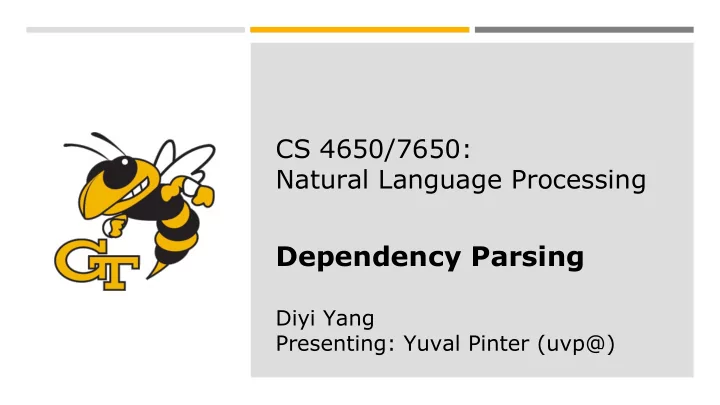

CS 4650/7650: Natural Language Processing Dependency Parsing Diyi Yang Presenting: Yuval Pinter (uvp@)
Representing Sentence Structure
Constituent (Phrase-Structure) Representation
Dependency Representation
Dependency Representation
Dependency Representation
Dependency vs Constituency ◼ Constituency structures explicitly represent ◼ Phrases (nonterminal nodes) ◼ Structural categories (nonterminal labels) ◼ Dependency structures explicitly represent ◼ Head-dependent relations (directed arcs) ◼ Functional categories (arc labels) ◼ Possibly some structural categories (parts of speech)
Dependency vs Constituency
Dependency Representation “CoNLL format”
Dependency Relations
Grammatical Functions Selected dependency relations from the Universal Dependency Set
Dependency Constraints ◼ Syntactic structure is complete (connectedness) ◼ Connectedness can be enforced by adding a special root node ◼ Syntactic structure is hierarchical (acyclicity) ◼ There is a unique pass from the root to each vertex ◼ Every word has at most one syntactic head (single-head constraint) ◼ Except root that does not have incoming arcs ◼ This makes the dependencies a tree
Projectivity ◼ Projective parse ◼ Arcs don’t across each other ◼ Mostly true for English ◼ Non-projective structures are needed to account for ◼ Long-distance dependencies ◼ Flexible word order
Projectivity ◼ Dependency grammars do not normally assume that all dependency-trees are projective, because some linguistic phenomena can only be achieved using non-projective trees. ◼ But a lot of parsers assume that the output trees are projective ◼ Reasons: ◼ Conversion from constituency to dependency ◼ The most widely used families of parsing algorithms impose projectivity
Dependency Treebanks ◼ The major English dependency treebanks converted from the WSJ sections of the PTB (Marcus et al., 1993) ◼ OntoNotes project (Hovy et al., 2006, Weischedel et al., 2011) adds conversational telephone speech, weblogs, usenet newsgroups, broadcast, and talk shows in English, Chinese and Arabic ◼ Annotated dependency treebanks created for morphologically rich languages such as Czech, Hindi and Finnish, e.g., Prague Dependency Treebank (Bejcek et al., 2013) ◼ https://universaldependencies.org/ (122 treebanks, 71 languages) ◼ Different schemas exist - not all treebanks follow the same attachment rules
The Parsing Problem
The Parsing Problem ◼ This is equivalent to finding a spanning tree in the complete graph containing all possible arcs
Evaluation ◼ Which is bigger?
Evaluation ◼ Which is bigger? ◼ Does 90% sound like a lot?
Parsing Algorithms ◼ Graph based ◼ Minimum Spanning Tree for a sentence ◼ McDonald et al.’s (2005) MSTParser ◼ Martins et al.’s (2009) Turbo Parser ◼ Transition based ◼ Greedy choice of local transitions guided by a good classifier ◼ Deterministic ◼ MaltParser (Nivre et al., 2008)
Graph-Based Parsing Algorithms ◼ Start with a fully-connected directed graph ◼ Find a Minimum Spanning Tree ◼ Chu and Liu (1965) and Edmonds (1967) algorithm
Chu-Liu Edmonds Algorithm
Chu-Liu Edmonds Algorithm ◼ Select best incoming edge for each node
Chu-Liu Edmonds Algorithm ◼ Subtract its score from all incoming edges
Chu-Liu Edmonds Algorithm ◼ Contract nodes if there are cycles
Chu-Liu Edmonds Algorithm ◼ Recursively compute MST
Chu-Liu Edmonds Algorithm ◼ Expand contracted nodes
Chu-Liu Edmonds Algorithm ◼ Expand contracted nodes Who sees a potential problem?
Scores ◼ Word forms, lemmas, and parts of speech of the headword and its dependent. ◼ Corresponding features from the contexts before, after, between the words ◼ Word embeddings / contextual embeddings from LSTM or Transformer ◼ The dependency relation itself ◼ The direction of the relation (to the right or left) ◼ The distance from the head to the dependent
Parsing Algorithms ◼ Graph based ◼ Minimum Spanning Tree for a sentence ◼ McDonald et al.’s (2005) MSTParser ◼ Martins et al.’s (2009) Turbo Parser ◼ Transition based ◼ Greedy choice of local transitions guided by a good classifier ◼ Deterministic ◼ MaltParser (Nivre et al., 2008)
Transition Based Parsing ◼ Greedy discriminative dependency parser ◼ Motivated by a stack-based approach called shift-reduce parsing originally developed for analyzing programming languages (Aho & Ullman, 1972)
Configuration ◼ Basic transition-based parser. The parser examines the top two elements of the stack and selects an action based on consulting an oracle that examines the current configuration
Configuration
Operations At each step choose: • Shift
Operations At each step choose: • Shift • LeftArc (Reduce left)
Operations At each step choose: • Shift • LeftArc (Reduce left) • RightArc (Reduce right)
Shift-Reduce Parsing
Shift-Reduce Parsing
Shift-Reduce Parsing
Shift-Reduce Parsing
Shift-Reduce Parsing
Shift-Reduce Parsing
Shift-Reduce Parsing
Shift-Reduce Parsing
Shift-Reduce Parsing
Shift-Reduce Parsing
Shift-Reduce Parsing
Shift-Reduce Parsing
Shift-Reduce Parsing
Shift-Reduce Parsing ◼ Oracle decisions can correspond to unlabeled or labeled arcs
Training an Oracle ◼ The Oracle is a supervised classifier that learns a function from the configuration to the next operation ◼ How to extract the training set?
Training an Oracle
Training an Oracle: Features ◼ POS, word-forms, lemmas on the stack/buffer ◼ Morphological features for some languages ◼ Previous relations ◼ Conjunction features
Learning ◼ Before 2014: SVMs ◼ After 2014: Neural Nets
Chen & Manning 2014
Chen & Manning 2014
Stack LSTM (Dyer et al. 2015) ◼ Instead of recalculating features, configuration updates via NN
Limitations of Transition Parsers ◼ Oracle prediction - early mistakes are very expensive. Solutions: ◼ Different transition systems (arc-standard vs. arc-eager) ◼ Beam Search
Limitations of Transition Parsers ◼ Oracle prediction - early mistakes are very expensive. Solutions: ◼ Different transition systems (arc-standard vs. arc-eager) ◼ Beam Search ◼ Can only produce projective trees. Solutions: ◼ Complicate the transition system (SWAP action) ◼ Apply post-parsing, language-specific rules
Summary ◼ Graph based ◼ + Exact or close-to-exact decoding ◼ - Weaker features ◼ Transition based ◼ + Fast ◼ + Rich features of context ◼ - Greedy decoding ◼ - Projective only
Recommend
More recommend